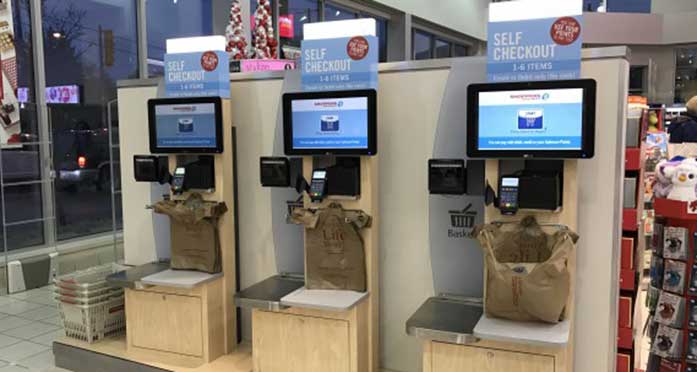 Only a few years ago, self-checkouts were seen as job killers by many Canadians.
Only a few years ago, self-checkouts were seen as job killers by many Canadians.
Grocers just didn’t know what to think of self-checkouts.
And consumers had a love-hate relationship with them. Some saw them as job killers, replacing humans who desperately needed employment. Others quietly used them, either preferring a speedy exit or simply avoiding unnecessary human interaction, making self-checkouts valuable for anti-socialites.
But with the pandemic, self-checkouts are becoming more popular, and grocers have noticed.
Since the start of the pandemic, 25 per cent of Canadians have changed where they typically shop for groceries, according to a recent survey by the Agri-Food Analytics Lab at Dalhousie University, in partnership with Caddle. The survey was conducted in mid-to-late May 2021 and included 10,024 Canadians.
Twenty-five per cent is an astonishing number. Of this group, a good portion of respondents admitted that a switch was necessary due to declared COVID-19 cases related to the store they regularly visited. Consumers are clearly concerned about potential exposure to the virus – or anything else, for that matter.
In the same survey, Canadians were asked how they intend to exit the grocery store in months to come. A whopping 53.2 per cent of respondents intend to use self-checkouts regularly over the next six months or so. And 60.1 per cent of generation Z members (born between 1997 and 2005) and millennials (born between 1981 and 1996) are planning to use self-checkouts more often. Self-checkouts are almost as popular as cashiers now.
Barely two years ago, these numbers were quite different. According to CivicScience, in 2019 only 19 per cent of customers ages 55 and older were willing to use self-checkout counters, compared to 35 per cent of customers between the ages of 35 and 54. The youngest customers have always been more open to using them, but that percentage was only 42 per cent in 2019. At the time, cashiers were still the most popular choice for all demographic groups.
Throughout the pandemic, grocers have noticed more people are using self-checkouts. So more stores are installing more machines. Even those stores that removed their machines are putting them back.
Many will remember record-breaking sales by grocers last year but 2021 presents a very different scenario. Statistics Canada recently reported that grocery store sales had dropped more than 1.5 per cent for the third month in a row.
Grocers will need to work hard to retain their market share and make their customers feel safe, and self-checkouts will likely be part of the strategy.
While visiting the grocery store, our focus now is on staying physically distant from others. It’s only natural to do the same while exiting the store.
Some Canadians will continue to use cashiers, but their numbers will still be lower than before the pandemic.
We expect more grocers to adopt more technologies to make the whole grocery shopping experience safer, and perhaps even less social, in the aftermath of the pandemic. We don’t know how long this will last, but the use of new technologies to make everything more efficient, more capital-focused and less dependent on labour will likely grow, to the dismay of organized labour.
But few want underpaid employees who are constantly exposed to contamination. With margins being so low in food retailing, paying staff more would mean eventually increasing food prices. We will need to appreciate this at some point if we want grocery employees to earn a decent living.
Self-checkout technology has never been great. Scanning issues, weighing the wrong produce, coding discounts and other problems at self-checkouts are numerous.
Unlike banking machines, which have operated seamlessly over the last 30 years, grocers have had issues creating an enjoyable self-checkout experience for most customers.
In many cases, the experience is interrupted by an embarrassing call for assistance from a nearby clerk whose only job is to save you from technological misery.
But with more shoppers committed to using self-checkouts, we expect some changes for the better.
For grocers, the exit has always been the most mismanaged part of the shopping experience. Self-checkouts are only part of our grocers’ journey to embrace innovation that helps make our trips less onerous.
Grocers went from fast cashiers with few items in the 1970s and 1980s, to self-checkouts in the 1990s, to perhaps a self-checkout model in which stopping at the exit is no longer necessary. One day, we will likely be able to exit a store as everything in our smart carts is automatically scanned. The cart would do the calculating for you and the store.
Self-checkouts aren’t about replacing humans. They’re more about how we can more effectively use humans to make the grocery industry more efficient.
Dr. Sylvain Charlebois is senior director of the agri-food analytics lab and a professor in food distribution and policy at Dalhousie University.
Sylvain is one of our Thought Leaders. For interview requests, click here.
The views, opinions and positions expressed by columnists and contributors are the authors’ alone. They do not inherently or expressly reflect the views, opinions and/or positions of our publication.

